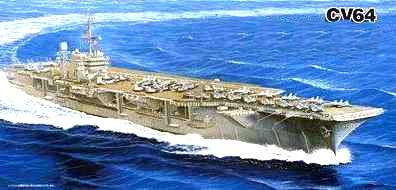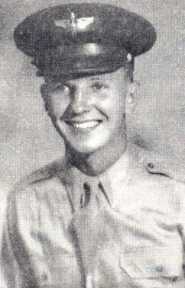|
Harpoon Cruise Missile Escort 11 July 1981.
VF-24 was again operating from USS Constellation in the Pacific, southwest of San Diego, for "work-ups," the  standard training before a lengthy deployment. This time we were out for one month, but the trip would include three days in Pearl Harbor, which was always nice. standard training before a lengthy deployment. This time we were out for one month, but the trip would include three days in Pearl Harbor, which was always nice.
I had been in the squadron two and a half months, and my regular pilot was LT John "John Boy" Alling, who had completed one deployment.
John Boy and I had a 5 AM brief. I was up at 4:00. Yes that is early, even on a carrier. But our mission was to “escort” a Harpoon missile launched from a submarine, which was something different so I had plenty of energy. The Harpoon people told us that test missiles such as this had extensive instrumentation but no way of indicating missile heading, so they needed a fighter to escort each missile and ensure it was not going off-course. As part of this test a P-3 patrol aircraft would launch another Harpoon in an attempt at simultaneous impact on the target ship; fellow VF-24 crew Cowboy and Ice were to escort that missile. A third missile was to be launched by a destroyer and escorted by an F-14 from VF-211.
The Harpoon's profile was for a low altitude flight to the target, 200’ or less guided by a radar altimeter, at the high speed of 0.9 Mach – about 540 knots. Those flight parameters would be exciting. I thought it was great that VF-24 would assign me (a new RIO) and Cowboy (a new pilot) to this high-visibility mission, but of course we both flew with someone more experienced. This was a major exercise, with three launch platforms and an abandoned US Navy ship anchored in the open ocean as a target. The flight brief was thorough – how to contact the submarine, air refueling support, and dozens of other details – but still the actual flight would require a great deal of resourcefulness. We called this “headwork.”
We launched at 7 AM, and Cowboy and Ice rendezvoused on us. The first thing we did was aerial refuel from a KA-6 tanker so our tanks were topped-off, then we flew to the missile shoot area about 200 miles south of the Constellation. Once in the area we split up: the VF-211 jet flew to the destroyer, Cowboy found the P-3, and we headed for the submarine’s location. John Boy descended to 10,000’ where we found that it is very difficult to spot a submarine when only the periscope is above the water…but not impossible. After a few minutes we gained sight. We then flew a circle around the tiny wisp that the sub’s periscope left on the surface of the ocean. High winds whipped up small whitecaps that made the periscope wake blend in so we paid constant attention. Cowboy and Ice were flying formation at 250 knots on an aircraft 116’ long with a 100’ wingspan while John Boy and I chased a wispy submarine periscope wake…but I was glad we had the sub.
We stayed in orbit above the sub about two hours while various factors were evaluated for this test shot. The destroyer had a problem with their Harpoon launcher, causing a delay. We eventually reached bingo fuel for the missile escort. After all, we had to plan on five minutes at high speed and low altitude, which would mean very high fuel consumption, and then add a fuel reserve. Another KA-6 tanker was sent in our direction and all F-14s aerial refueled again. Then we had to find the submarine’s periscope again.
After about three hours someone made the decision that the missiles would not be launched that day, and we headed back to Connie. I wasn’t really disappointed, as all of the coordination and flying had been interesting. The weather was perfect, too. We landed and logged 3.7 hours of flight time. We then learned that the missile shoot was rescheduled for the next day and the same crews would fly escort. …Yes!!
The next day we briefed at 5:15 AM and followed the same routine: launch, rendezvous, aerial refuel, then fly south and find the Harpoon launchers. It was another beautiful, clear day. By this time the destroyer was out of the exercise with continuing launcher problems, so it was just the sub and the P-3. Things went smoothly and John Boy and I found ourselves comfortably orbiting the submarine periscope. The radio was very quiet, with occasional brief comments telling us to keep waiting. After two hours we refueled, then two hours later we did it again. Finding the periscope wake never became easier, but we became less stressed each time because we knew we would eventually find it.
Suddenly there was a new voice on our radio announcing two minutes until launch from the sub. After more than six hours of just waiting (over two days) we could hardly believe it! Soon the voice announced one minute. John Boy descended to about 200’ above the ocean and tightened his turn. The F-14 at low altitude and high speed is very responsive. With thirty seconds to go we were headed away from the launch direction in a hard left turn – this was the perfect position. As we completed the 180-degree turn and approached the periscope we got a countdown from ten seconds…three…two… one…op away (the code for missile launch).
There was a short delay before the Harpoon missile broke the surface a few yards ahead of the sub’s periscope, climbing at a 45? angle with a sense of purpose and a trail of white spray and smoke. “206 has a visual on the weapon” I transmitted over the radio, trying not to sound excited.
The missile climbed to several hundred feet, then arced over and quickly descended to its cruise altitude, gaining speed. John Boy instantly added power to max burner and we accelerated from 350 knots to 540 in just seconds. (Even with everything else going on, going to full burner in a Tomcat at low altitude got my attention. It is an inspiring demonstration of thrust.) As we approached the missile he reduced throttles to military power and we maintained a loose formation.
A Harpoon is basically a tube only 15’ long and a little over a foot in diameter, with little stub wings that stick out about a foot on each side. So on the minus side it was much smaller than anything we had flown formation on before. Also on the minus side: it flies at 200’, which is low. On the plus side: it was painted bright white, and it flew a very steady airspeed and altitude since it was guided by an autopilot.
Just as we were settling into formation for our 50-mile flight to the target ship, I heard a countdown for the P-3’s missile, then the “op away” call. Ice made a brief report that they had their missile in sight. This was cool.
Just a few minutes ago, John Boy and I had been at max conserve wondering if this would be another canceled event…and now we were chasing a cruise missile skimming across the ocean. I know people have been lower and faster, but 540 knots at 200' is low and fast.
John Boy got close to the missile so I could take a few photos using the clunky US Navy camera we carried, then backed out a little for comfort. Our jet could stay in formation using military power (maximum non-afterburner) if we were smooth, but with any change such as getting close to the missile or adjusting our heading John Boy had to tap burner – select afterburner for a few seconds. After a few moments I became comfortable at this speed and altitude. But we didn’t chat casually on the ICS – we were focused on the tasks associated with the mission.
In three minutes we had covered almost 30 miles and were more than halfway to the target ship. Ice came up on the radio: “Cowboy is visual, your right 4 o’clock.” Ice always sounded like he was bored – but calm is good in fighters. That transmission meant they could see us and they were on our right side. John Boy concentrated on flying while I looked to the right and saw the distinctive silhouette of a Tomcat a few miles away. “John Boy visual.”
As our two Harpoons approached the same target their flight paths were bound to converge. What happened next was unexpected.
John Boy and I saw Cowboy’s jet, but didn’t gain sight of the small Harpoon he was chasing. Both fighters were flying formation on our respective missiles when Cowboy’s crossed directly behind ours, very close. Cowboy became concerned and called for us to execute a max-performance collision avoidance turn: “Break left!”
John Boy went to burner and made a max-performance left turn, appropriate response for the call to "break." He immediately reversed hard right to remain close to the action. Cowboy came up on the radio again, “Okay, mine’s stabilized on the left side now, you can go back to yours.” We normally tried to use standard terminology on radio communications, but cruise missile escort wasn’t in the manual. Cowboy’s Texan drawl was the perfect complement to Ice’s laconic but always-informative commentary.
Soon we had two Harpoons in a rough formation and two Tomcats stabilized alongside them. All four vehicles were quickly approaching the target hulk at low altitude and high speed. The human operators were once again calm.
At their pre-set range the Harpoons executed a sharp pop-up maneuver that was briefed but which was surprising for its abruptness. How did they do that with those little stubby wings? This was our cue to detach anyway; we could see the target just a few miles ahead and the missiles were in their terminal phase, so John Boy climbed and flew over the target to watch the impacts. Cowboy and Ice immediately joined on us. Below, the Harpoons hit the target hulk and created small blasts and fires even though they had no explosive warheads, simply due to the energy and friction of steel missiles hitting a steel ship.
I reported the impacts to the exercise controller, who cleared us to return to Connie. Our mission was complete. We had sufficient fuel to return without refueling.
Due to the maneuvering I had lost the two cans of soda that I brought. A little embarrassed, I told John Boy. He rolled our jet inverted and chopped the throttles. The soda cans came out of their hiding place, fell to the Plexiglas canopy, and started to roll forward where I grabbed them. We rolled upright and had a little refreshment for our flight back to Constellation.
We completed an uneventful day carrier landing and logged 6.3 hours of flight time.
I did not fly for five days because I had gotten 10 hours in two days and the Schedules Officer was trying to keep flight hours even. I didn’t really mind – those were two great flights.
Ground job…ACM flights…periodic requalifying for carrier ops...squadron parties…written tests on the weapons system…afterburner displays to burn down to landing weight...cross-country flights…night aerial refueling…missile shoots…the VF-24 group at the Officers Club. The middle of 1981 consisted of six months that seem intense upon recollection, probably because of all the new experiences. I became a member of an organization in which each member counted; together we made VF-24. We identified ourselves as the Fighting Renegades.
|


